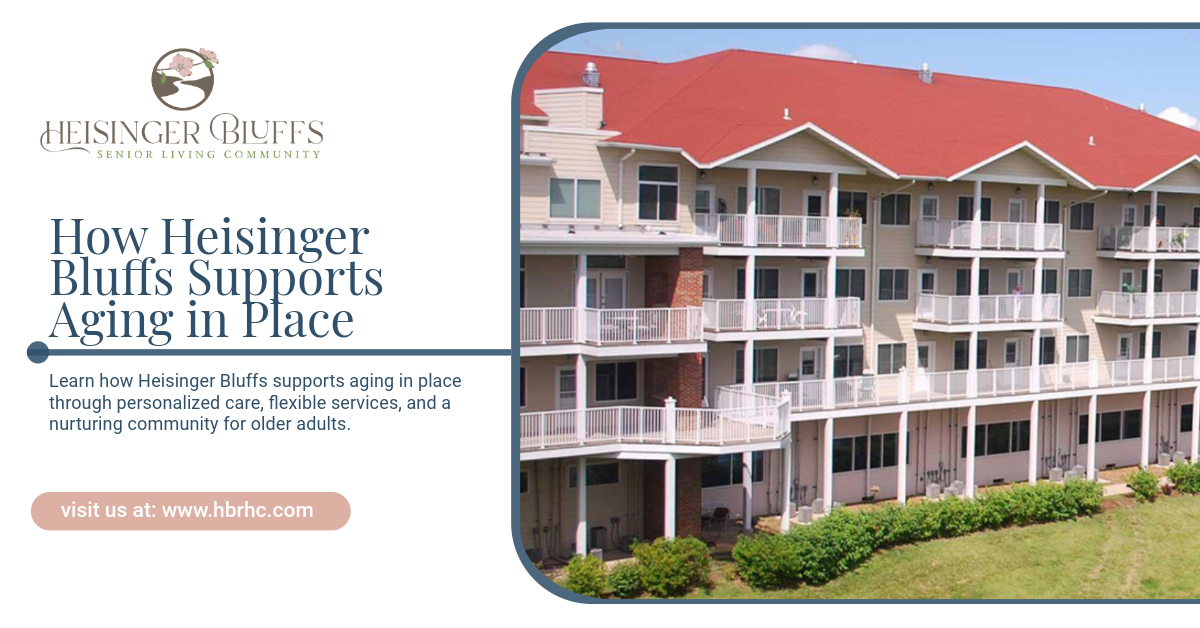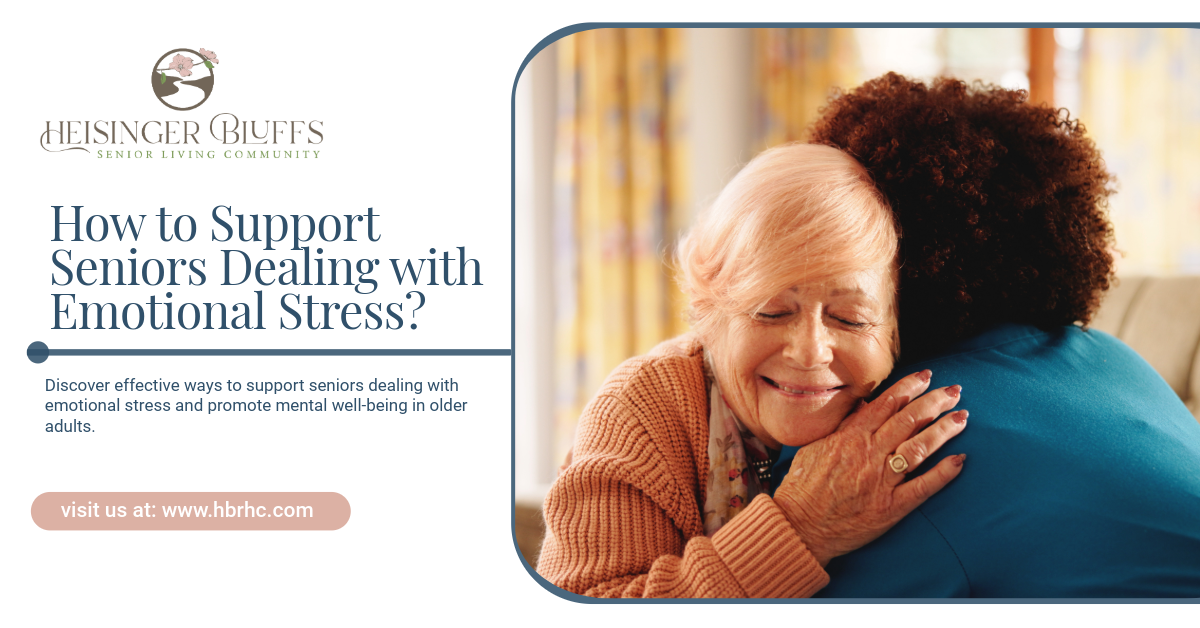How Heisinger Bluffs Supports Aging in Place

Aging in place means staying in a familiar environment while receiving the right support to maintain independence and quality of life. For many older adults, it represents the ability to grow older with dignity and comfort in a community they trust.
This blog explores how senior living communities like Heisinger Bluffs empower residents to age in place through customized care plans, adaptable living arrangements, and supportive services that evolve with changing needs.
What Does Aging in Place Really Mean?
Aging in place isn't about staying in one house forever. Instead, it's about remaining in a supportive, stable environment that offers both independence and assistance when needed. For some, this may mean staying in their own homes. For others, it could mean moving into a senior living community that allows them to access a range of care options as their health and abilities evolve.
Key Elements of Aging in Place:
- A familiar, secure environment
- Personalized care that evolves with changing needs
- Easy access to healthcare and support services
- Opportunities for meaningful social engagement
- Independence with safety
The Importance of Aging in Place for Seniors
Aging in place has been linked to improved emotional well-being, increased satisfaction, and greater control over daily life. Seniors who can remain in an environment where they feel safe and valued often experience:
- Less stress and anxiety
- A stronger sense of identity
- More stable routines and social connections
- Improved physical and mental health outcomes
Communities that are designed to support aging in place offer a balanced approach to independence and assistance—adjusting care as residents need more support.
How Senior Living Communities Facilitate Aging in Place
Senior living communities play a critical role in helping residents age in place. They do this by offering a continuum of care, flexible services, and an environment that promotes autonomy while preparing for future needs.
Key Features That Support Aging in Place in Senior Communities:
| Feature | Description |
|---|---|
| Continuum of Care | Residents can transition between independent living, assisted living, skilled nursing, or memory care without relocating. |
| 24/7 Staff Available | Nurses, aides, and caregivers are available to provide help when needed. |
| Customized Care Plans | Services are tailored to the individual’s current health and can evolve over time. |
| Wellness Programs | Preventative health services and fitness programs keep residents active and healthy. |
| Barrier-Free Design | Senior-friendly features like grab bars, wide doorways, and single-level layouts support mobility. |
Personalized Care That Evolves Over Time
One of the most important components of aging in place is flexible care. Residents often begin in independent or assisted living and may eventually require more intensive services. Rather than moving to a new facility, a well-designed community will simply adjust care levels as needed.
Examples of Evolving Care:
- Independent Living: Focus on autonomy, with minimal assistance.
- Assisted Living: Help with daily tasks like medication, dressing, and mobility.
- Skilled Nursing: 24/7 care for those with chronic or complex conditions.
- Memory Care: Specialized support for those with dementia or Alzheimer’s.
With this model, residents don’t need to leave behind their community, friends, or routines as their needs change.
Safety Features That Enable Independence
Aging in place is only possible when residents feel safe and supported. Senior communities integrate safety features into both residential and common areas to reduce fall risk and encourage confidence.
Common Safety Features:
- Emergency call systems in every apartment
- Well-lit hallways and entrances
- Non-slip flooring
- Grab bars in bathrooms
- Elevators and wide doorways for wheelchair access
These features not only help prevent accidents but also give residents and their families peace of mind.
Onsite Health Services and Support
Access to healthcare is another crucial part of aging in place. Having nurses and medical staff onsite makes it easier to manage chronic conditions, receive medication, and monitor health without leaving the community.
Health Services That Support Aging in Place:
- Regular wellness checks
- Physical therapy and rehabilitation
- Chronic disease management
- Medication assistance
- Transportation to medical appointments
These services help reduce hospital visits, support quicker recovery, and keep residents in their home environment longer.
Social Engagement and Mental Well-being
Social isolation is a major risk factor for seniors, often leading to depression, cognitive decline, and poor health. A key benefit of aging in place within a community setting is consistent access to social opportunities and enriching activities.
Community Life May Include:
- Clubs and interest groups
- Game nights and movie screenings
- Volunteer and mentorship programs
- Art, music, and educational classes
- Outings to parks, restaurants, and events
These activities encourage friendships, mental stimulation, and a sense of purpose—all of which are vital to healthy aging.
Nutritional Support for Healthy Aging
Proper nutrition is often overlooked but is essential for seniors’ physical and cognitive health. Community living helps residents eat well with access to planned meals that meet dietary needs and preferences.
Features of Senior Dining Programs:
- Balanced, nutritious meals prepared by culinary teams
- Dietitian input for medical conditions like diabetes or hypertension
- Meal options that consider texture or swallowing difficulties
- Flexible dining times and locations
This ensures seniors are eating regularly, enjoying their meals, and getting the nutrients they need to thrive.
Family Involvement and Peace of Mind
Aging in place isn’t just about the resident—it also impacts family members. Families want to know their loved one is safe, cared for, and happy. Senior communities foster open communication with families, offer visiting opportunities, and provide updates about health and well-being.
Ways Communities Keep Families Connected:
- Family education sessions and events
- Digital health records and updates
- Flexible visiting hours
- Involvement in care planning
When families are part of the journey, everyone feels more supported and informed.
Why Aging in Place in a Community Setting Works
The goal of aging in place is to maintain independence while receiving the right support at the right time. Senior living communities are uniquely equipped to provide this through structured care, thoughtful design, and a people-first philosophy.
Residents benefit from:
- Familiarity and continuity
- Predictable routines and staff
- Relationships that grow over time
- Personalized support without the need to move again
This integrated model creates a sense of belonging and security that’s difficult to replicate elsewhere.
Final Thoughts
For older adults seeking to age in place with dignity, comfort, and flexibility, choosing the right senior living community is essential. With comprehensive services, personalized care, and a deep commitment to residents’ well-being, Heisinger Bluffs provides a supportive environment where seniors can thrive as they grow older without needing to relocate again. It’s more than a place to live; it’s a place to call home. Contact us today!
Frequently Asked Questions
What services help seniors age in place at Heisinger Bluffs?
Heisinger Bluffs offers a full continuum of care, including independent living, assisted living, skilled nursing, and memory care, plus customized support services that evolve with the resident’s needs.
Can I remain in the same apartment as my care needs change?
Yes, residents can often stay in their same apartment while care services are adjusted to match their evolving health and mobility needs, depending on the community's specific policies.
How does a senior community prevent isolation while aging in place?
Through structured social activities, wellness programs, and community events, residents are encouraged to build relationships, stay active, and engage in meaningful experiences.
Sources:
- https://www.aarp.org/home-living/future-of-aging-in-place/
- https://www.ncoa.org/article/anxiety-and-older-adults-a-guide-to-getting-the-relief-you-need/
- https://www.ncoa.org/older-adults/health/physical-health/chronic-disease/
- https://jamanetwork.com/journals/jama/fullarticle/2819153
- https://www.myplate.gov/life-stages/older-adults











